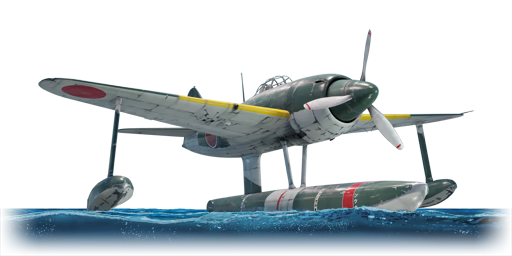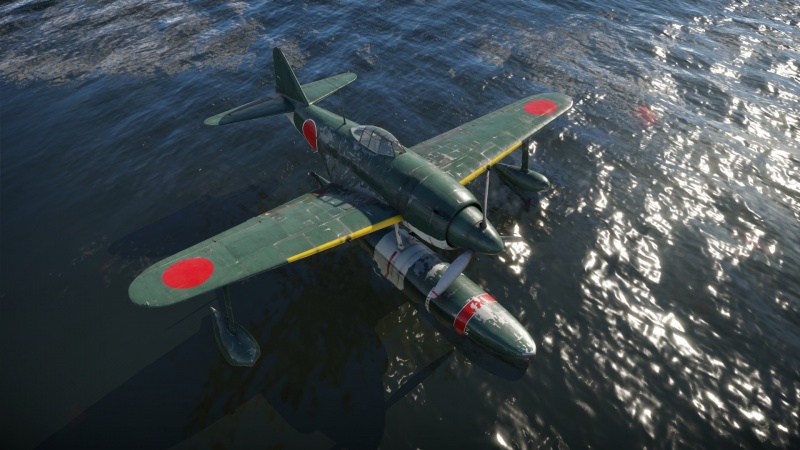Difference between revisions of "N1K1"
(→Usage in battles: Updated - Usage in battles refresh coming very soon!) |
TiMe_tO_FaiL (talk | contribs) m (Pros and cons) (Tag: Visual edit) |
||
| Line 172: | Line 172: | ||
* Poor climb-rate and turn time with floats on. | * Poor climb-rate and turn time with floats on. | ||
* Average acceleration and top speed can make you vulnerable. | * Average acceleration and top speed can make you vulnerable. | ||
| + | * 7.7 mm machine guns overheat easily. | ||
== History == | == History == | ||
Revision as of 21:41, 5 March 2021
| This page is about the Japanese fighter N1K1. For other uses, see N1K (Family). |
Contents
Description
The N1K1 Kyofu is a rank II Japanese hydroplane fighter with a battle rating of 2.7 (AB/SB) and 2.3 (RB). It was introduced in Update 1.65 "Way of the Samurai".
The Allied reporting name for this aircraft was "Rex".
The N1K1 can be a great low rank fighter. Even though its flight characteristics may seem poor at first, there are several ways you can improve them on the battlefield.
General info
Flight performance
The N1K1 doesn't have great flight characteristics. With an average turn time and rate of climb, it can struggle against other planes at its BR. However, removing the floats can significantly help its turn time.
| Characteristics | Max Speed (km/h at 6,000 m) |
Max altitude (metres) |
Turn time (seconds) |
Rate of climb (metres/second) |
Take-off run (metres) | |||
|---|---|---|---|---|---|---|---|---|
| AB | RB | AB | RB | AB | RB | |||
| Stock | 473 | 462 | 10000 | 19.9 | 20.6 | 11.5 | 11.5 | 500 |
| Upgraded | 507 | 489 | 18.1 | 19.0 | 19.2 | 14.9 | ||
Details
| Features | ||||
|---|---|---|---|---|
| Combat flaps | Take-off flaps | Landing flaps | Air brakes | Arrestor gear |
| ✓ | ✓ | ✓ | X | X |
| Limits | ||||||
|---|---|---|---|---|---|---|
| Wings (km/h) | Gear (km/h) | Flaps (km/h) | Max Static G | |||
| Combat | Take-off | Landing | + | - | ||
| 0 | 600 | 400 | 400 | 350 | ~7 | ~7 |
| Optimal velocities (km/h) | |||
|---|---|---|---|
| Ailerons | Rudder | Elevators | Radiator |
| < 430 | < 300 | < 400 | > 324 |
| Compressor (RB/SB) | ||
|---|---|---|
| Setting 1 | ||
| Optimal altitude | 100% Engine power | WEP Engine power |
| 1,600 m | 1,440 hp | 1,607 hp |
| Setting 2 | ||
| Optimal altitude | 100% Engine power | WEP Engine power |
| 5,000 m | 1,280 hp | 1,428 hp |
Survivability and armour
The survivability of the N1K1 is to be expected of Japanese planes. With non-effective self-sealing fuel tanks, it won't survive a lot of shots, specially if it catches on fire.
Modifications and economy
Armaments
Offensive armament
The N1K1 is armed with:
- 2 x 20 mm Type 99 Model 1 navy cannons, wing-mounted (100 rpg = 200 total)
- 2 x 7.7 mm Type 97 navy machine guns, nose-mounted (550 rpg = 1,100 total)
Suspended armament
The N1K1 can be outfitted with the following ordnance:
- Without load
- 2 x 60 kg Navy Type 97 Number 6 bombs (120 kg total)
Usage in battles
The N1K1, though adequate for most situations, can be a pretty difficult aircraft to master. Its poor turn times and climb rates can make you vulnerable at low altitude.
If someone is to use this aircraft in battle, he must take advantage of his guns. They can be pretty powerful, so boom-and-zoom attacks would be recommended. You should avoid turn-fights, specially with British aircraft, though you should be able to out-turn some German aircraft.
Manual Engine Control
| MEC elements | ||||||
|---|---|---|---|---|---|---|
| Mixer | Pitch | Radiator | Supercharger | Turbocharger | ||
| Oil | Water | Type | ||||
| Controllable | Controllable Not auto controlled |
Controllable Not auto controlled |
Controllable Not auto controlled |
Separate | Controllable 2 gears |
Not controllable |
Pros and cons
Pros:
- Centre float can protect the plane from attacks from below.
- You can ram other planes with the float (esp. the wings).
- Can be a great boom-and-zoom aircraft.
- Self-sealing fuel tanks and armour, a feature not found on many low-rank Japanese aircraft.
- Powerful 20 mm cannons.
- More ammo for the cannons compared to the A6M2 (200 vs 120).
- Accelerates very fast in a dive, and does not lose the speed created by the dive right away.
Cons:
- Poor climb-rate and turn time with floats on.
- Average acceleration and top speed can make you vulnerable.
- 7.7 mm machine guns overheat easily.
History
Development
With the start of the Sino-Japanese war, the navy required a new line of planes for the southern expansion. One of these required planes by the navy was a fighter seaplane. Before World War I, it was not uncommon for seaplanes to play a central role in combat missions, but closing into World War II seaplanes were usually only used for observation and reconnaissance missions.
This plane was thought to be needed as some islands simply didn't have enough place for an airfield and were too trivial to send aircraft carriers towards. Which at the time of the Japanese situation seemed like a proper investment.
In September of 1940 the Imperial Japanese Navy instructed Kawanishi, who were quite experienced in developing seaplanes, to make a prototype plane under the name of 15-Shi Seaplane Fighter.
The chief design engineer appointed for this specification was Shizuo Kikuhara, who also worked on the H8K2. Kikuhara and his team were up to quite a task as comparing this specification to the A6M2 mod. 11 that was just put into service in China. The speed exceeded by 30 knots, cruising range was two-thirds, armament was equal.
Simply put, the team was required to make a seaplane with the same performance as of the new main fighter and particularly the speed requirement was almost unrealizable for a seaplane (in 1940) let alone a interceptor like the Raiden which its prototype (J2M1) barely had a top speed of 578 km/h.
The maximum speed of the first completed prototype N1K missed the requirement by nearly 100 km/h, but Shizuo Kikuhara and his team would put all their technical efforts to achieve the requirement.
Nakajima also made a seaplane fighter of their own as temporarily bridge for the N1K until it actually entered service. This seaplane was simply making use of the new A6M2 mod. 11, making it more waterproof and adding pontoons on it. The A6M2-N would be adopted as the Type 2 seaplane fighter on July 6, 1942.
After alot of development and trail time the N1K1 with a Kasei 13 engine would finally be adopted as the Kyōfū in December 21, 1943.
But during its adoption, the Americans already were waging a victory in the Solomon islands and the need for a seaplane fighter was no longer needed as Japan was on the defensive now.
Usage
Some Kyōfū's were based in Indonesia and were used as a interceptor of bombers with the use of aerial bombs that would detonate after a short time attempting to bomb American bombers such as B-24/PB4Y's and B-29's.
Other Kyōfū's were stationed in the mainland, primarly at Sasebo Air Group and the Otsu Air Group but have almost no record of battle.
In the end, the Kyōfū was little too late as its stopgap replacement, the A6M2-N, primarily filled its role. However this indirectly opened its way to evolve in the Shiden.
Media
By: -Juno- TakaLeon
See also
- Related Development
- N1K1 - (Kyofu Model 11; Base hydroplane model)
- N1K1-Ja - (Shiden Model 11A; N1K1-J with 7.7mm's removed from the fuselage and 4x20mm in the wings)
- N1K2-J - (Shiden Kai Model 21; Redesigned wings and fuselage)
- N1K2-Ja - (Shiden Kai Model 21A; More powerful engine, larger prop)
External links
| Kawanishi Aircraft Company (川西航空機) | |
|---|---|
| Fighters | J6K1 |
| N1K | N1K1-Ja · N1K2-J · N1K2-Ja |
| Bombers | H6K4 · H8K2 · H8K3 |
| Hydroplane | N1K1 · E7K2 |
| Japan fighters | |
|---|---|
| Navy | |
| Carrier-based fighter | |
| A5M | A5M4 · Hagiri's A5M4 |
| A6M | A6M2 mod. 11 · A6M2 · A6M3 · A6M3 mod. 22 · A6M3 mod. 22Ko · A6M5 · A6M5 Ko · A6M5 otsu · A6M5 Hei · A6M6c |
| A7He | A7He1* |
| A7M | A7M1 (NK9H) · A7M2 |
| Land-based Fighter | |
| J2M | J2M2 · J2M3 · J2M4 Kai · J2M5 · J2M5 (30 mm) |
| J6K | J6K1 |
| J7W | J7W1 |
| N1K-J | N1K1-Ja · N1K2-J · N1K2-Ja |
| Fighter seaplane | |
| N1K | N1K1 |
| A6M-N | A6M2-N |
| Army | |
| Ki-10 | Ki-10-I · Ki-10-I C · Ki-10-II · Ki-10-II C |
| Ki-27 | Ki-27 otsu · Ki-27 otsu Tachiarai |
| Ki-43 | Ki-43-I · Ki-43-II · Ki-43-III otsu |
| Ki-44 | Ki-44-I · Ki-44-I 34 · Ki-44-II otsu · Ki-44-II hei |
| Ki-61 | Ki-61-I ko · Ki-61-I otsu · Ki-61-I hei · Tada's Ki-61-I hei · Ki-61-I tei · Ki-61-II Otsu Kai |
| Ki-84 | Ki-84 ko · Ki-84 otsu · Ki-84 hei |
| Ki-87 | Ki-87 |
| Ki-94 | Ki-94-II |
| Ki-100 | Ki-100 · Ki-100-II |
| Other countries | ▅F4U-1A · ▅P-51C-11-NT · ▅Bf 109 E-7 · ▅Fw 190 A-5 |
| *Imported designation of the He 112 (A6M was in development - A7M would take A7 designation after the cancelation of the A7He) | |





